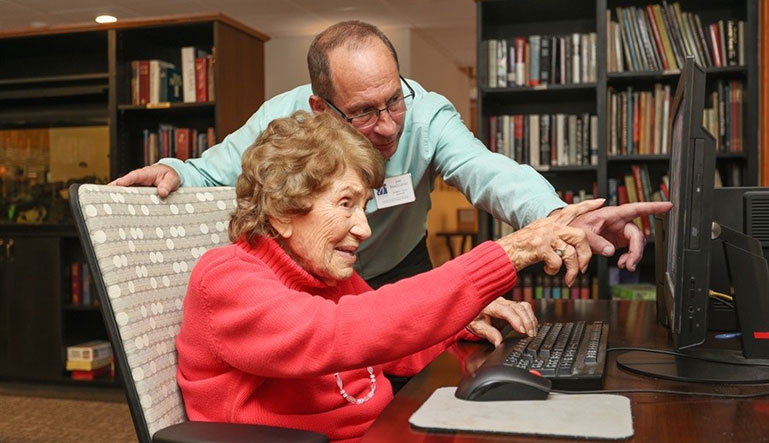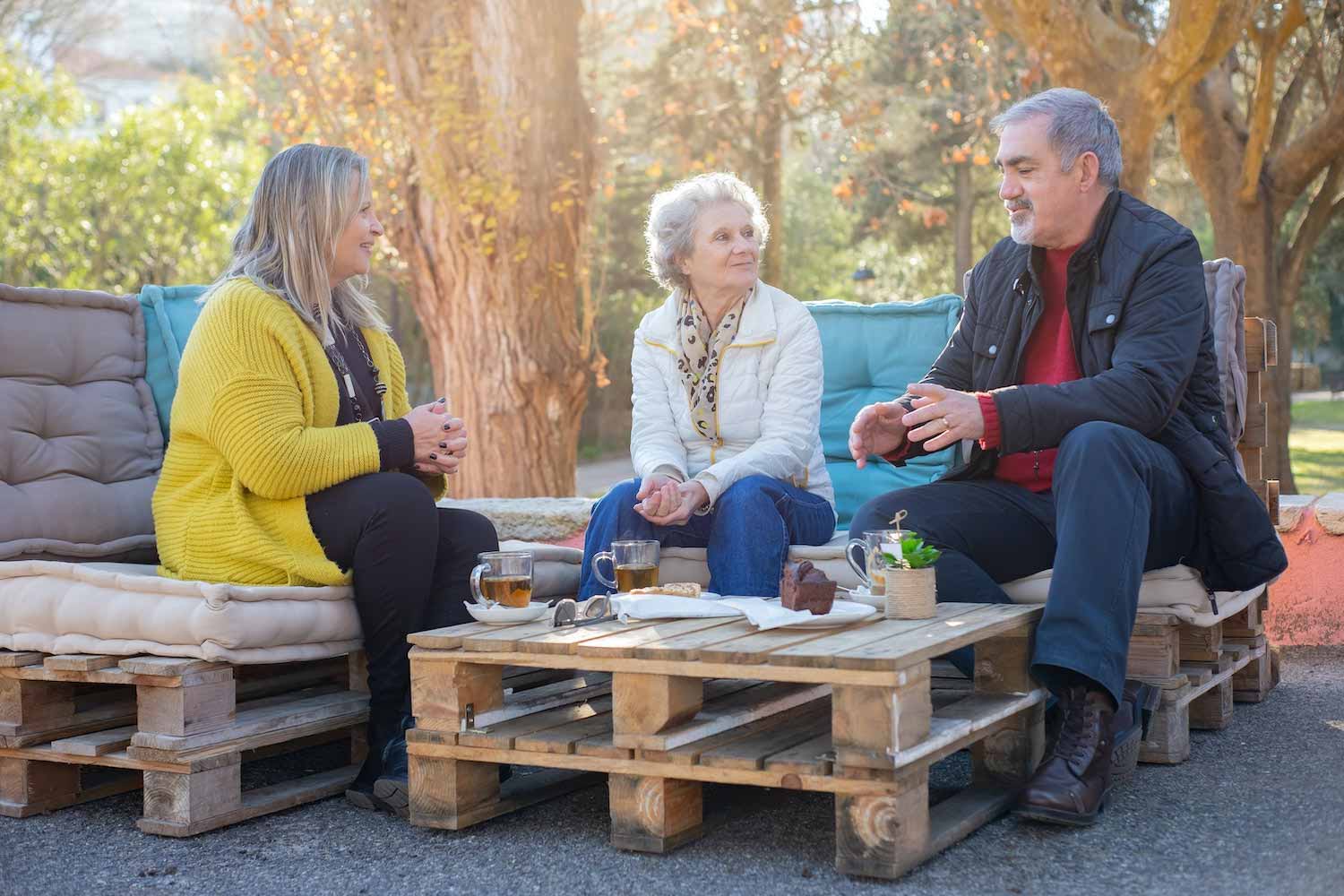Retirement is something most people look forward to for years. Trips abroad, seeing the country, rediscovering hobbies and reawakening passions long submerged during the childrearing and working years is a vivid image for many. Once you retire, however, things might not go as hoped or planned. The household chores and maintenance that kept you busy all those years haven’t gone away, and sometimes they’ve become harder to do. A bigger portion of your budget goes toward hired services, such as lawn care. Those costs and the cost of upkeep for your home can then limit your travel plans, and you may feel ready to direct your time and energy toward your family and living life in retirement to the fullest without being burdened by the stress of home upkeep. This is where independent living comes in.
Moving to a senior independent living community can be a big transition, and it’s easy to feel overwhelmed by different amenities and fees when looking for the right independent living community for you. This article will provide answers to all of your questions, including:
- How much does independent living actually cost, and is it worth it?
- How does the cost of independent living compare with staying at home?
- Can I afford independent living? How can I pay for it?
Read on to learn more about what living in an independent living community is like, how much it costs, and how you can make it work (financially and otherwise!) for you.
Table of Contents
- What is an independent living community?
- Are independent living communities expensive?
- How much does independent living cost?
- Factors that Affect How Much Independent Living Costs
- What is included in the average monthly cost for independent living?
- How much does independent living cost compared to aging in place?
- How can I pay for independent living?
- The Five Star Difference: Stress-Free Independent Living
What is an independent living community?
Independent living communities, also known as retirement communities, are senior living neighborhoods designed especially for older adults. They are a good option for folks in their sixties, seventies, eighties and beyond who want to spend more time living and less time ‘doing,’ as in handling the burdens of home ownership.
Are independent living communities expensive?
You may be under the impression that independent living communities are expensive, but you may be surprised by the value they offer. In fact, once you consider all you get when you move to independent living, you might consider it a best buy.
How much does independent living cost?
The median monthly cost of senior independent living in the United States in 2025 is $3,065 according to SeniorLiving.org Research, but varies widely depending on several factors like location, services, and amenities. Five Star Senior Living communities come in all shapes and sizes and are located across the country in rural and urban settings. Each community offers unique amenities, but they all offer the same dedication and excellence to residents.
Factors that Affect How Much Independent Living Costs
Type of independent living community. A stand-alone independent living community, for example, might offer fewer features and amenities but be more cost effective. Many independent living communities are priced similarly to a typical apartment in the area. An independent living community located on the campus of a continuing care community, however, will likely come with more services and amenities, which may result in a higher price tag.
Location. The location of an independent living community has a big impact on its cost, as cost of living varies widely in different areas of the country. Major metropolitan areas typically have multiple senior living options but a higher cost of living. That translates to higher monthly fees. Cost of independent living will be higher in the more desirable neighborhoods. Size matters, too. Square footage of your independent living floor plan will influence the monthly fee.
Services and Amenities Included in Independent Living. The financial, physical, and emotional costs of caring for your lawn, keeping up with home maintenance, and cooking every meal can add up. What’s important to remember is that the services provided by an independent living community come at a cost that is actually a bargain when you consider what it could cost to purchase services separately. Lawn care, upkeep, housekeeping—these costs can add up quickly.
What is included in the average monthly cost for independent living?
The true value of independent living goes far beyond a new place to call home. Independent living communities offer a wide variety of amenities and services included in the monthly cost to make your retirement as stress-free and enriching as possible. Amenities and fees vary by community, but here is just a sampling of what may be included in your monthly costs when moving to an independent living community:
- Housekeeping, maintenance and groundskeeping services One aspect of independent living communities that cannot be overstated is the convenience factor. There are team members to take care of chores, such as housekeeping, maintenance, snow removal and lawn care.
- Spacious floor plans including studio, one, or two-bedroom apartments. When it comes to senior living housing, there’s a misconception that rooms are small, institutional, or look like college dorms. This couldn’t be further from the truth. Five Star independent living apartments are charmingly designed, comfortably spacious, and come in a variety of sizes and styles. Plus, every apartment comes equipped with great amenities to make you feel right at home.
- Nutritious, chef-prepared meals served restaurant-style in the dining room. Older adults sometimes say their relationship with food has changed with age—not just eating but cooking as well. That’s understandable when you consider that some medications decrease appetite and special diets limit options. Chronic medical conditions such as diabetes or heart disease also play a part. Take out the salt and sugar, and suddenly food becomes less interesting. Most independent living communities are aware of this and offer a variety of healthy meal options that still please the palate. Some communities accommodate restricted diets. For those who love to cook or make their own food for health reasons, some offer a kitchen or kitchenette in each apartment to give the home chef a culinary playground.
- Utilities. The cost of utilities is different in every community, but often are included in the monthly room costs. These utilities can include cable television, electricity, internet, housekeeping, and water all bundled together for one convenient monthly cost.
- A sense of community and a full calendar of active senior activities and clubs to choose from. Moving to an independent living community can significantly improve older adults’ quality of life. Residents in these communities are often close in age and share similar interests with their neighbors. Communities also offer both formal and informal opportunities for connecting. A morning cup of coffee and conversation in the lounge or garden is a great way to start the day. Joining friends for restaurant-style lunch or dinner makes mealtime more enjoyable and meaningful. And playing a game of cards in the den can end the day with a smile. There’s no shortage of activities to dive into. (In fact, you may find you have too much to do, but in a good way.)
- Transportation services for errands, appointments and other community outings. Independent living communities at Five Star offer you the ability to get where you need to go. Transportation services offer scheduled rides to doctor’s appointments, grocery stores, and fun community outings to museums and entertainment.
- Wellness programs and senior-friendly fitness activities. Onsite senior fitness classes build not just strength and flexibility but social connections. Feel refreshed after a sit and stretch class, head to the pool for water aerobics, or join a walking club to make your mornings active.
- Safe and secure environment where medical care is easily accessible if needed. Because safety is often a concern—especially as people age and walking becomes more difficult—residences are designed with the needs of older adults in mind, such as handrails, grab bars, emergency call systems and good lighting. If a medical emergency does occur, there are systems in place to summon help.
- Access to on-site amenities. Enjoy life at home with movie nights, game clubs, barber shop/hair salon, heated pool, library, physical therapy services, and more.
How much does independent living cost compared to aging in place?
The cost saving benefits of independent living don’t stop at utilities and home maintenance. Independent living at a senior living community gives you the freedom and purpose to pursue hobbies, make meaningful social connections, and stay engaged with an array of activities. Many communities offer independent living and assisted living under the same roof so you can age in place if you require more medical and daily assistance. The transition from independent to assisted living can be smooth while you reap the benefits of a stress-free lifestyle focused on enhancing your independence.
How can I pay for independent living?
Most seniors pay for independent living with private funds; however, the monthly cost of independent living can become much more manageable through senior living financing options like:
- A Bridge Loan or Senior Line-of-Credit: These short-term, “interest-only” loans help fund assisted living costs until the necessary money comes in.
- Deferred Annuity with Long-term Care Rider: Rather than making monthly insurance payments, the investor places a lump sum of money into a deferred annuity. They can then withdraw the money, tax-free and without any IRS penalties, to pay for assisted living.
- Life Settlement Accounts: With a life settlement agreement, a senior sells their life insurance to a third party and receives a lump sum payment.
- Veteran’s Benefits: US veterans and the surviving spouses of veterans can receive monthly benefits to pay for assisted living through the Aid and Attendance Benefit.
The Five Star Difference: Stress-Free Independent Living
Moving to an independent living community is much more than a real estate decision; it’s a quality of life decision. The programs, services and amenities our independent living communities offer can take away the worry and add a lot of joy—not a bad tradeoff. Five Star’s independent living experts are happy to help answer your questions about independent living costs. In a Five Star independent living community, our residents enjoy the value and the active lifestyle they deserve. Most importantly, though, they are welcomed into a new home sweet home where life is stress-free, and friends become family.
Download our FREE Guide to the Cost of Senior Living eBook and find out if there’s a Five Star community near you. Contact us to learn more.
Contact Us Today
"*" indicates required fields


![How Much Does Assisted Living Cost? [2025]](https://www.fivestarseniorliving.com/wp-content/uploads/2022/07/cost-of-assisted-living-blog-hero.jpg?ver=1710517178)
![How Much Does Memory Care Cost? [2025]](https://www.fivestarseniorliving.com/wp-content/uploads/2022/07/i-Nvm8GsN-X3.jpg?ver=1710520827)






